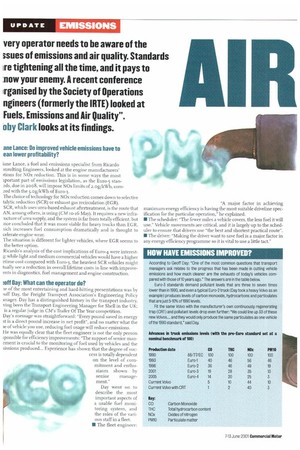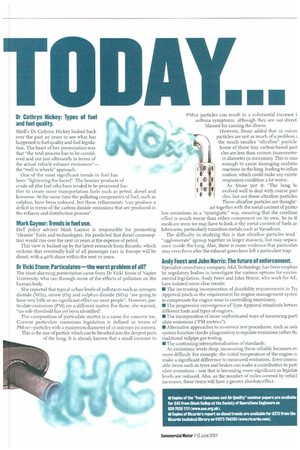ane Lance: Do improved vehicle emissions have to lean lower profrtahility?
Page 28

Page 29

If you've noticed an error in this article please click here to report it so we can fix it.
iane Lance, a fuel and emissions specialist from Ricardo )nsulting Engineers, looked at the engine manufacturers' itions for NOx reduction. This is in some ways the most iportant part of emissions legislation, as the Euro-5 stan.rds, due in 2008, will impose NOx limits of 2. og/kWh, cornred with the 5.ogikWh of Euro-3.
The choice of technology for NOx reduction comes down to selective talytic reduction (SCR) or exhaust gas recirculation (EGR). SCR, which uses urea-based exhaust aftertreatment, is the route that AN, among others, is using (CM ro-i6 May). It requires a new infra-ucture of urea supply, and the system is far from totally efficient, but nce concluded that it was more viable for heavy trucks than EGR, rich increases fuel consumption dramatically and is thought to celerate engine wear.
The situation is different for lighter vehicles, where EGR seems to the better option.
Ricardo's analysis of the cost implications of Euro-4 were interestg: while light and medium commercial vehicles would have a higher etime cost compared with Euro-3, the heaviest SCR vehicles might tually see a reduction in overall lifetime costs in line with improveents in diagnostics, fuel management and engine construction.
off Day: What can the operator do?
ie of the most entertaining and hard-hitting presentations was by !off Day, the Freight Transport Association's Engineering Policy anager. Day has a distinguished history in the transport industry, ving been the Transport Engineering Manager for Shell in the UK; is a regular judge in CM's Trailer Of The Year competition.
Day's message was straightforward; "Every pound saved in energy it is a direct pound increase in net profit", and no matter what the )e of vehicle you use, reducing fuel usage will reduce emissions.
He was equally clear that the fleet engineer is not the only person >ponsible for efficiency improvements: The support of senior manement is crucial to the monitoring of fuel used by vehicles and the iissions produced... Experience has shown that the degree of success is totally dependent on the level of commitment and enthusiasm shown by
senior management."
Day went on to describe the most important aspects of a usable fuel monitoring system, and the roles of the various staff in a fleet.
• The fleet engineer: "A major factor in achieving maximum energy efficiency is having the most suitable driveline specification for the particular operation," he explained.
• The scheduler: "The fewer miles a vehicle covers, the less fuel it will use." Vehicle movements are critical, and it is largely up to the scheduler to ensure that drivers use "the best and shortest practical route".
• The driver: "Making the driver want to save fuel is a major factor in any energy efficiency programme so it is vital to use a little tact."
Dr Cathryn Hickey: Types of fuel and fuel quality.
Shell's Dr Cathryn Hickey looked back over the past zo years to see what has happened to fuel quality and fuel legislation. The heart of her presentation was that "the total process has to be considered and not just ultimately in terms of the actual vehicle exhaust emissions"— the "well to wheels" approach.
One of the most significant trends in fuel has been "lightening the barrel". The heavier products of crude oil (the fuel oils) have tended to be processed further to create more transportation fuels such as petrol, diesel and kerosene. At the same time the polluting components of fuel, such as sulphur, have been reduced, but these refinements "can produce a deficit in terms of the carbon dioxide emissions that are produced in the refinery and distribution process".
Mark Gaynor: Trends in fuel use.
DoT policy advisor Mark Gaynor is responsible for promoting "cleaner" fuels and technologies. He predicted that diesel consumption would rise over the next ro years at the expense of petrol.
This view is backed up by the latest research from Ricardo, which reckons that eventually half of all passenger cars in Europe will be diesel, with a 40% share within the next ro years.
Dr Vicki Stone: Particulates—the worst problem of all?
The most alarming presentation came from Dr Vicki Stone of Napier University, who ran through some of the effects of pollution on the human body.
She reported that typical urban levels of pollutants such as nitrogen dioxide (NO2), ozone (03) and sulphur dioxide (S02) "are going to have very little or no significant effect on most people". However, particulate emissions (PM) are a different matter. For these, she warned, "no safe threshold has yet been identified".
The composition of particulate matter is a cause for concern too. Current particulate emissions legislation is defined in terms of PM10—partides with a maximum diameter of to microns (o.ornan).
This is the size of particle which can be breathed into the deepest parts of the lung. It is already known that a small increase in PMro particles can result in a substantial increase i asthma symptoms, although they are not direct: blamed for causing the illness.
However, Stone added that ro micro particles are not as much of a problem the much smaller "ultrafine" particle Some of these tiny carbon-based part des are less than roonm (nanometre: in diameter (o.000nnm). This is sma enough to cause damaging oxidatio reactions in the lung, leading to inflan mation, which could make any existir respiratory condition a lot worse. As Stone put it: 'The lung hi
CI qt. evolved well to deal with coarse part des, but not these ultrafine particles These ultrafine particles are thought' act together with the metal content of partici late emissions in a "synergistic" way, meaning that the combinc effect is much worse than either component on its own. So in d medium term we may have to look at the metal content of fuels ar lubricants, particularly transition metals such as Vanadium. The difficulty in studying this is that ultra fine particles tend "agglomerate" (group together in larger masses), but may separa once inside the lung. Also, there is some evidence that particulau may even form after the exhaust gases have left a particulate trap.
Andy Feest and John Norris: The future of enforcement.
Specialist consultancy company, AEA Technology, has been employ by regulatory bodies to investigate the various options for enviro mental legislation. Andy Feest and John Norris, who work For AE, have isolated some clear trends: • The increasing incorporation of durability requirements in Tyi Approval (such as the requirement for engine management systen to compensate for engine wear in controlling emissions).
• The progressive convergence of Type Approval standards betwe( different fuels and types of engines.
• The incorporation of more sophisticated ways of measuring parti ulate emissions ("PM metrics").
• Alternative approaches to in-service test procedures, such as usii system function checks (diagnostics) to regulate emissions rather thi traditional tailpipe gas testing.
III The continuing internationalisation of standards.
As emissions levels drop, measuring them reliably becomes ev more difficult. For example, the initial temperature of the engine make a significant difference to measured emissions. Even consur able items such as tyres and brakes can make a contribution to part ulate emissions—one that is becoming more significant as legislati levels are reduced. Also, as the number of miles covered by vehicl increases, these items will have a greater absolute effect.




































































































